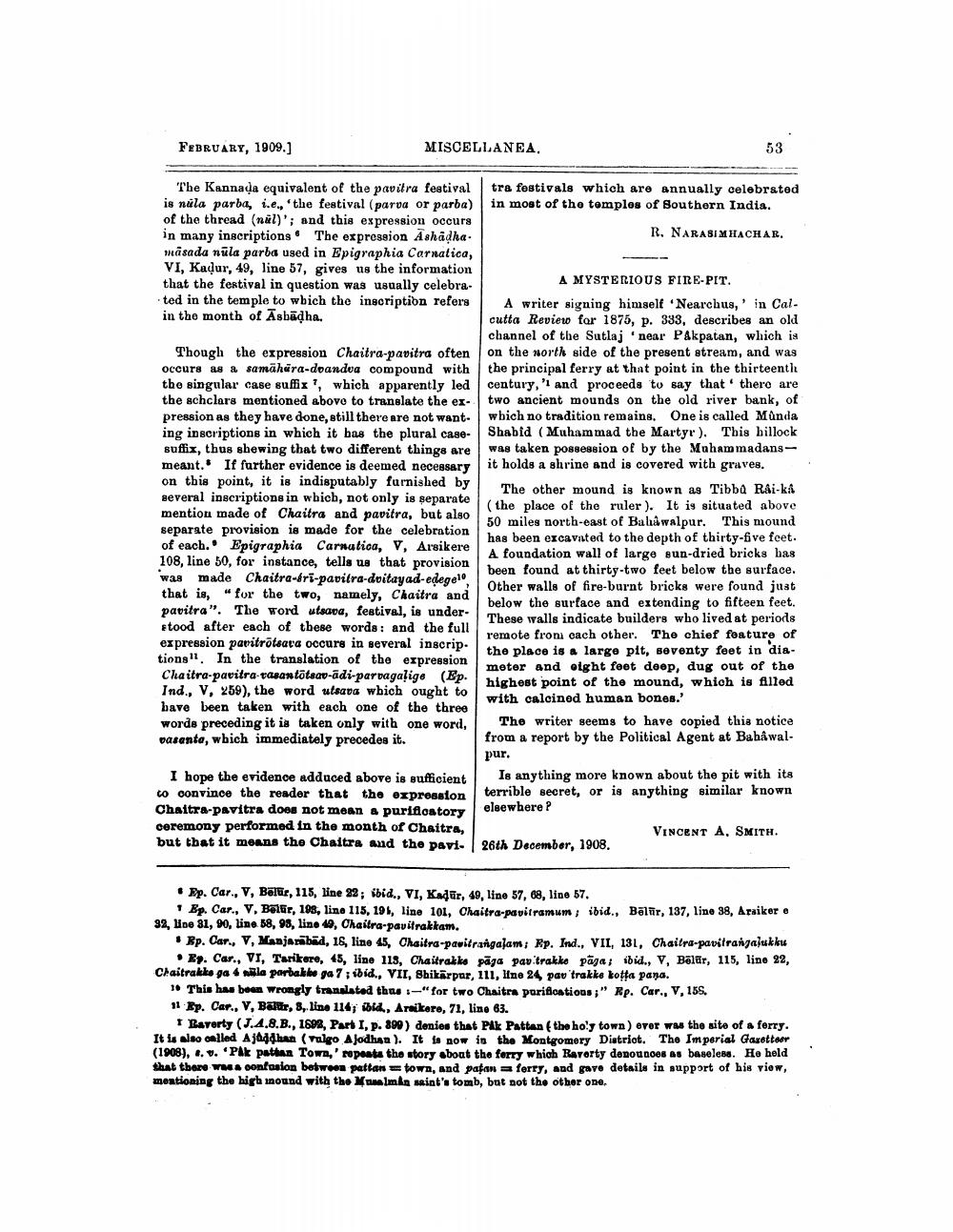________________
FEBRUARY, 1909.]
MISCELLANEA.
53
The Kannada equivalent of the pavitra festival tre festivals which are annually celebrated is nula parba, i.e. 'the festival (parva or parba) in most of the temples of Southern India. of the thread (nåll'; and this expression occurs in many inscriptions. The expression Ashadha.
R. NARASIMHACHAR. māsada nula parba used in Epigraphia Carnatica, VI, Kadur, 49, line 57, gives us the information that the festival in question was usually celebra
A MYSTERIOUS FIRE-PIT. ted in the temple to wbich the inscription refers A writer signing himself 'Nearchus, in Cal. in the month of Asbūdha.
cutta Review for 1875, p. 333, describes an old
channel of the Sutlaj near PÅkpatan, which is Though the expression Chaitra-pavitra often on the north side of the present stream, and was occurs as a samahara-doandog compound with the principal ferry at that point in the thirteenth the singular case suffix!, which apparently led century, '1 and proceeds to say that there are the achclars mentioned above to translate the ex- two ancient mounds on the old river bank, of pression as they have done, still there are not want. wbich no tradition remains. One is called Munda ing inscriptions in which it has the plural case- Shabid (Muhammad the Martyr). This billock suffix, thus shewing that two different things are was taken possession of by the Muhammadans meant. If further evidence is deemed necessary it holds a shrine and is covered with graves. on this point, it is indisputably furnished by
The other mound is known as Tibba Rai-ka several inscriptions in which, not only is separate
(the place of the ruler). It is situated above mention made of Chaitra and pavitra, but also
50 miles north-east of Balawalpur. This mound separate provision is made for the celebration
has been excavated to the depth of thirty-five feet. of each. Epigraphia Carnatica, V, Arsikere
A foundation wall of large sun-dried bricks has 108, line 50, for instance, tells us that provision
been found at thirty-two feet below the surface. was made Chaitra-fri-pavitra-dvitayad-edegel, that is," for the two, namely, Chaitra and
Other walls of fire-burnt bricks were found just
below the surface and extending to fifteen feet. pavitra". The word utsava, festival, is under
These walls indicate builders who lived at periods stood after each of these words: and the full
remote froni cach other. The chief feature of expression pavitrātsara occurs in several inscrip.
the place is a large pit, seventy feet in diations. In the translation of the expression
meter and eight feet deep, dug out of the Chaitra-pavitra-vasantotsav-ādi-parvagaligo (Ep.
highest point of the mound, which is filled Ind., V, 259), the word utsata which ought to
with calcined human bones.' bave been taken with each one of the three worde preceding it is taken only with one word, The writer seems to have copied this notice vasanta, wbich immediately precedes it.
from a report by the Political Agent at Babawal.
pur. I hope the evidence adduced above is sufficient
Is anything more known about the pit with its Lo convince the reader that the expression
terrible secret, or is anything similar known Chaitra-pavitra does not mean & purifloatory
elsewhere? ceremony performed in the month of Chaitra,
VINCENT A. SMITH. but that it means the Chaitra and the pavi. 26th December, 1908.
. Ep. Car., V, Balar, 115, line 22, ibid., VI, Kedūr, 49, line 57, 68, line 57.
1 Ep. Car., V. Balar, 108, line 115, 196, line 101, Chaitra-pavitramum , ibid., Balur, 137, line 38, Araikere 32, loe 81, 90, line 58, 98, line 19, Chaitra-pavitrakkam.
• Rp. Car., V, Manjarübüd, 16, line 45, Chaitra-pavitrangalam; Rp. Ind., VII, 131, Chaitra-pavitrangalukku
• Ry. Car., VI, Tarikore, 45, line 118, Chaitrakka pāga pav trakko pāga; ibid., V, Bölür, 115, line 22, Chaitrakke ga 4 mila parbaklega 7: ibid., VII, Shikärpar, 111, Uno 24 pav trakke kotta pana.
1. This has been wrongly translated tha:-" for two Chaitra purificatious;" Rp. Car., V, 155. 11 Ep. Car., V, Balter, 8, line 114; ibid, Aruikers, 71, line 63.
1 Raverty (J.A.8.B., 1600, Part I, p. 890) denies that Pik Pattan the holy town) over was the site of a ferry. It is sino onlled Ajdhan (valgo Ajodhan ). It is now in the Montgomery District. The Imperial Gasettar (1908), 4. v. 'Pak pathan Town,' repeats the story aboat the ferry which Ravorty denounces as baseless. He held that there ww. confusion betwoon pattan town, and pagan = ferry, and gave details in support of his view, mentioning the high inound with the M almin saint's tomb, but not the other one




